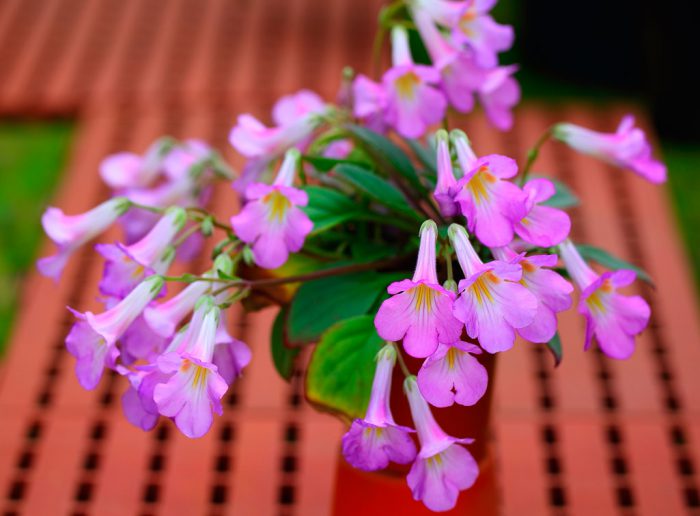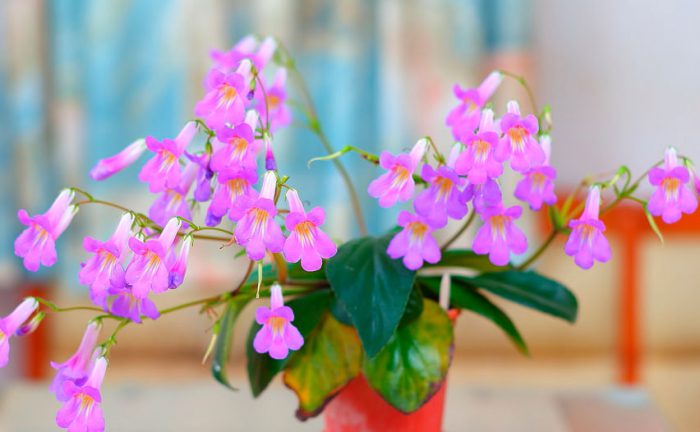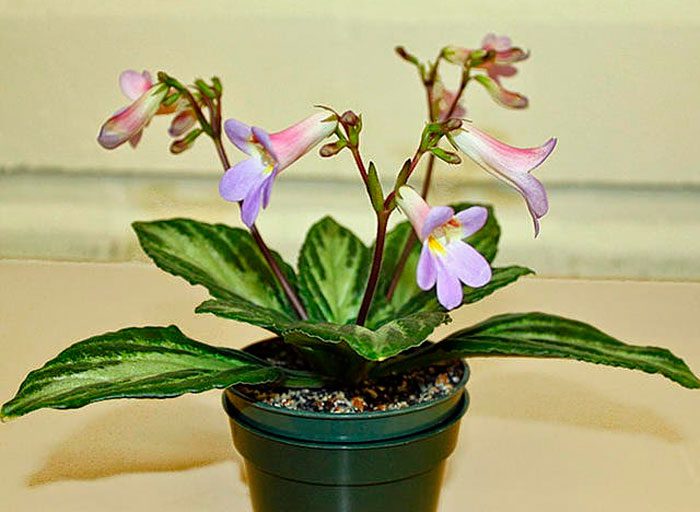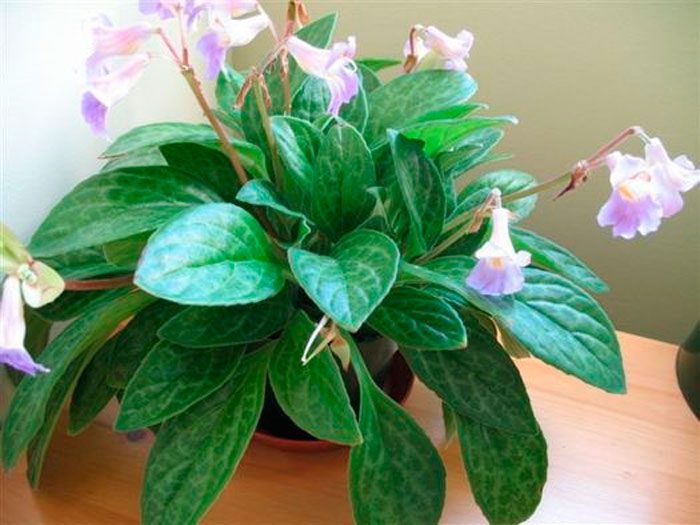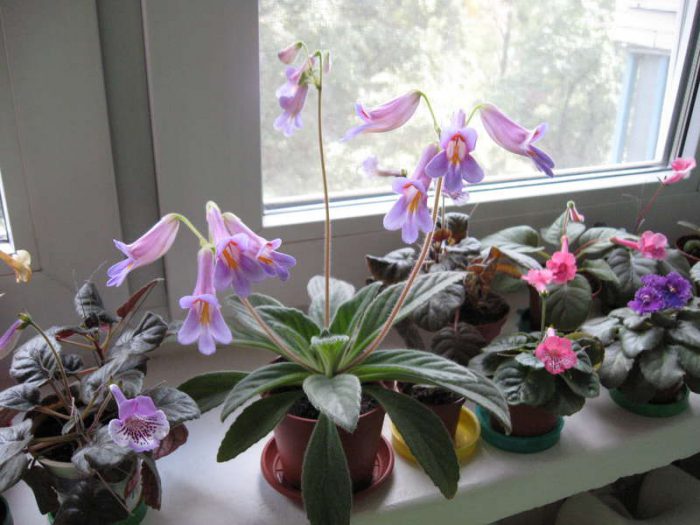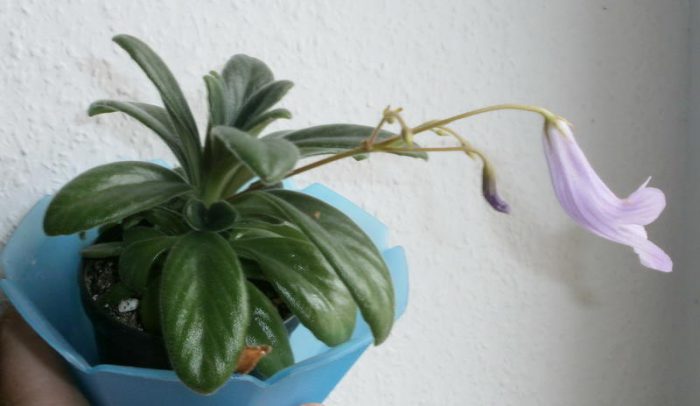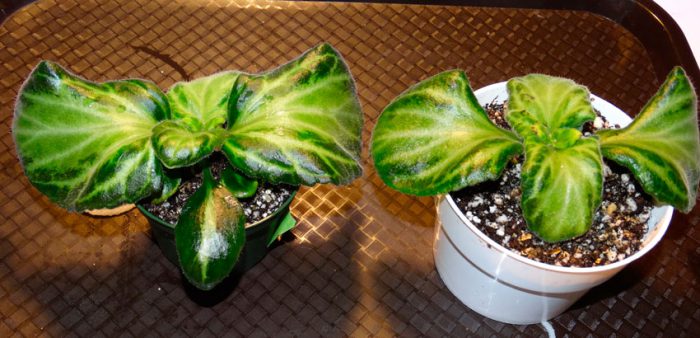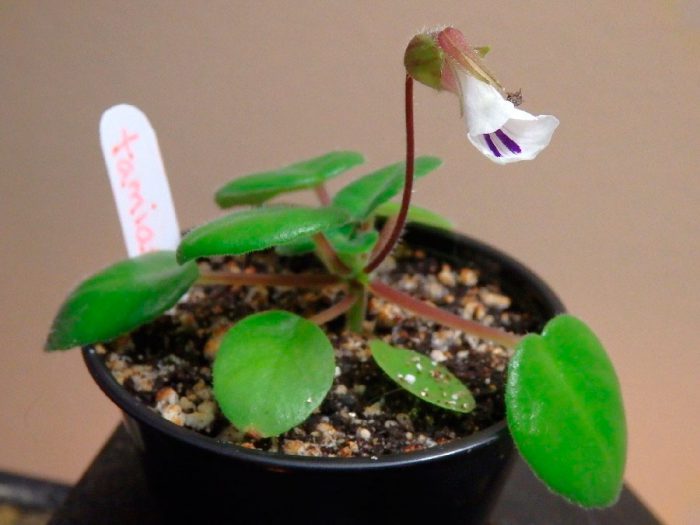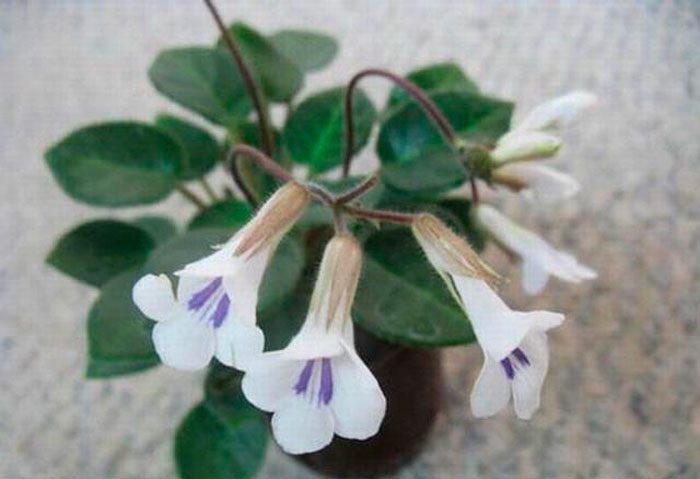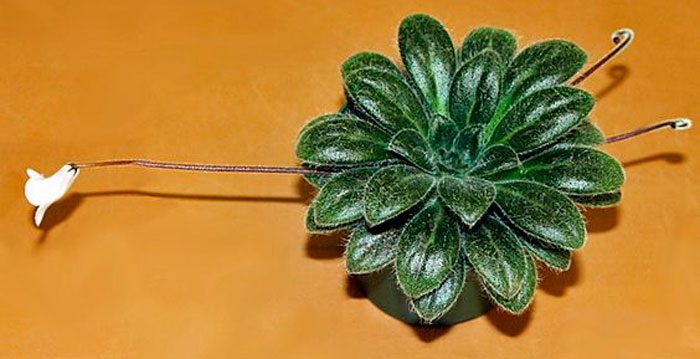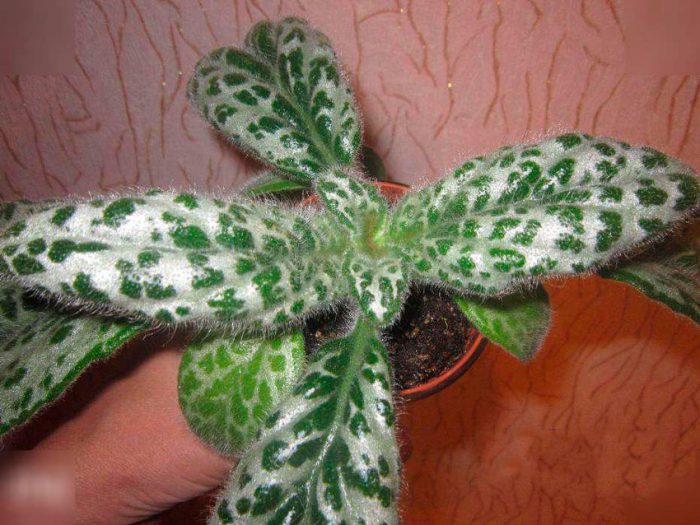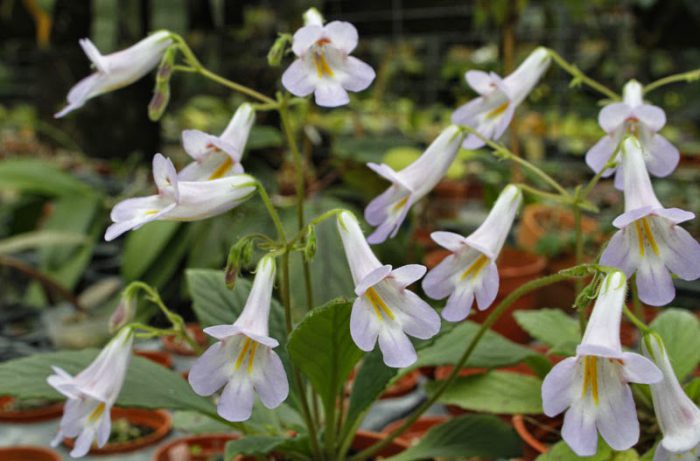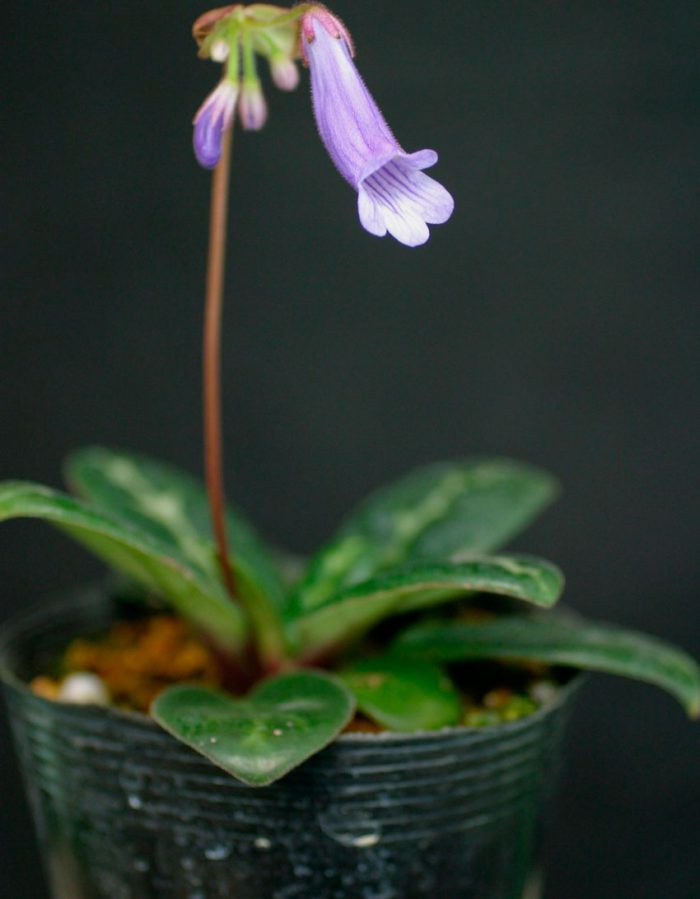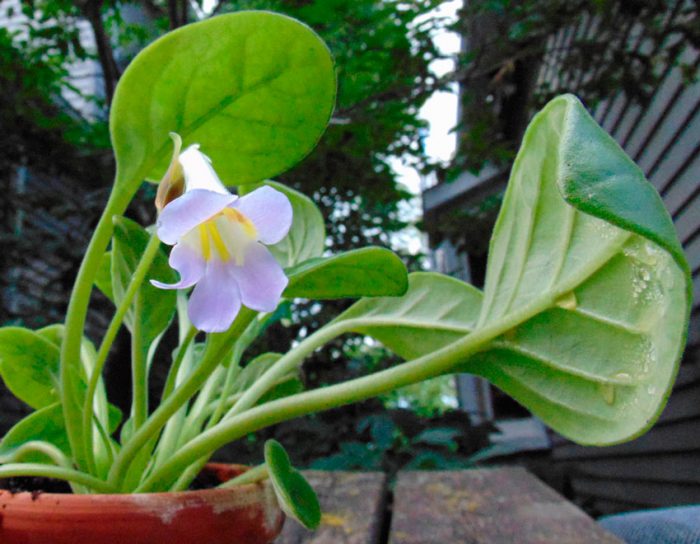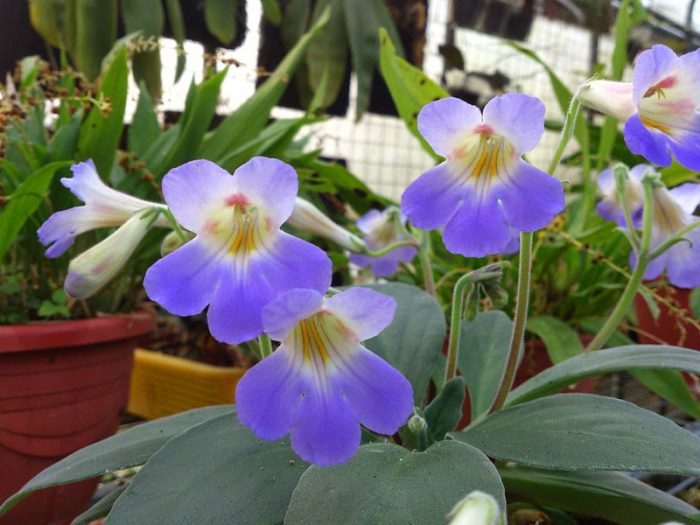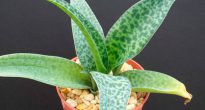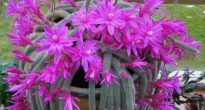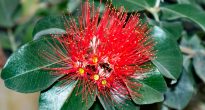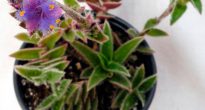Such cute, delicate, magical, exotic and unusual flowers, as primulines were previously called hirit. The leaf plates of these plants have extremely unusual symmetry. They are distinguished by incredibly graceful flowers, as well as their unpretentiousness. In such a plant, almost everything is unique, incredibly delicate and beautiful. Such flowers are perfect for those florists who seek to find a cute, compact and extremely unusual plant that can become the "pearl" of the home collection. However, you should not be afraid that primulina is a rather rare plant, because it is relatively simple and easy to care for. Florists have not yet had time to appreciate such a flower, but it is rightfully considered one of the best rare plants.
Content
- 1 Features of primulina
- 2 Home care for primrose
- 3 Primuline types
- 3.1 Primulina tobacco (Primulina tabacum)
- 3.2 Primulina Tamiana (Primulina Tamiana)
- 3.3 Double primulina (Primulina gemella)
- 3.4 Chinese primulina
- 3.5 Primulina linearifolia (Primulina linearifolia)
- 3.6 Longgang primulina (Primulina longgangensis)
- 3.7 Small-spotted primulina (Primulina minutimaculata)
- 3.8 Primulina spadiciformis (Primulina spadiciformis)
- 3.9 Primulina Sabromboidza (Primulina subrhomboidea)
- 4 Primuline varieties
Features of primulina
Florists are just beginning to get acquainted with such unusual beauties as primulines, and therefore they have not yet gained the deserved popularity. So, for example, spirulina could have been found not so long ago, perhaps in single collections. Today it is considered a little-known and very exotic plant, but many flower growers already know that such a cute "baby" has a very unpretentious disposition and can become a decoration of any collection. Such a name as "primulina" is known only to a small number of flower growers. However, those who have seen such flowers at exhibitions or in home collections will forever remember their unusual and very delicate beauty. There are many examples when a florist, having first met such a beauty, has already returned to his home with several copies.
Primulines (Primulina) - these are quite rare southeastern exotic plants that are grown at home. Their homeland is Asia. Even today, new species are being discovered that are found in the highlands of Malaysia, India, China, and Sri Lanka. But at the same time, the largest number of species of such plants come from Thailand and China. Primulines are directly related to the Gesneriev family. Such plants began to be grown at home no more than 20 years ago.Several years ago, changes were made to their classification, which was perceived as a revolution in botany. So, this genus was previously considered monoid, however, thanks to the research carried out, it has expanded to more than 100 plant species, which were earlier called Chirita. This name is still often used by flower growers to this day, so this beauty is often called primulines-hirit, and sometimes just chirit. However, despite the confusion in the names, such cute flowers are quite easy to recognize, even considering the variety of their species.
Such a plant has a very effective rosette of leaves. It is often compared to the leaf rosette of the uzambar violet, however, apart from the size and type of development, they no longer have anything in common. It should be noted that these flowers have practically no resemblance to violets, especially these plants differ in leaf plates. However, there are types of primulins that from a distance are somewhat reminiscent of a violet. This flower has leaves arranged symmetrically, which is unique. They are almost always arranged in perfect opposite pairs. So, each sheet plate necessarily has an "opposite". Outwardly, this symmetry makes the plant spectacular and very elegant, while the flower itself is mistaken by many for a small miracle. In most species, rosettes do not have stems. And there are species in which a short stem is formed. Also, such plants are distinguished by the fact that they grow wide all the time, so there are species and varieties in which the leaf rosette is rather large (diameter is about 40 centimeters). There are species that create peculiar tiers due to the fact that lateral plants grow in them. It is also worth remembering that an adult plant does not lose its spectacular appearance. So, its unique symmetry does not disappear anywhere. In different species, the size of leaf rosettes can vary from very large to miniature (dwarf). The height of such plants, as a rule, does not exceed 20 centimeters, but most plants are much shorter.
Only in some species the leaves are outwardly distantly similar to the violet. They are located opposite and have short or medium petioles. Their surface can be glossy, slightly pubescent, as well as velvety (with thick hairs). The shape of the leaf plates directly depends on the type and variety and can be ovoid, rhombic, round, linear, spatulate or lingual. In a greater number of species, on the surface of the leaves, stripes and veins of light or silver color. It is impossible to appreciate all the beauty of the leaves in the photographs. The fact is that light patterns seem to shine, and if you look at such a plant live, you get the impression that liquid silver is spilled onto the leaves, which flows continuously. This effect is somewhat similar to that of precious orchids.
The graceful flowers of this plant can compete in their beauty with orchids, but their structure and shape are quite simple. Such flowers have a certain resemblance to gloxinia, as well as gentian. The five-petalled flowers are tubular in shape, while their tube is rather narrow. And they have a light pastel or whitish color. On the surface of the flower itself and the asymmetrical throat are stripes of lilac and dark purple colors. On rather long peduncles, the height of which always exceeds the height of the leaf rosette, there are inflorescences in the shape of a brush. They are quite loose and consist of 3–7 flowers. In the inflorescences, the flowers, as well as the leaves, are arranged symmetrically and not very densely, which contributes to emphasizing the beauty and grace of this plant during flowering.
Flowers can be painted not only in specific lilac-white tones. Thanks to breeders, a large number of varieties were born, the flowers of which can be painted in pink, yellow, blue, white, blue, as well as lilac. The main color of the flower is distinguished by its tenderness, pastel and dullness.But the veins have a brighter and more saturated color shade.
With all its above-described advantages, this plant also blooms for a very long time. So, the duration of flowering, it can compete with phalaenopsis. So, flowering lasts almost constantly and is interrupted only during the dormant period, which is rather short. As a rule, the flowering of species primulines begins in the summer, and in order for it to continue in the winter, illumination is required. Flowering in varietal plants lasts year-round with one break for a short dormant period in winter.
Home care for primrose
Both experienced flower growers and beginners will be able to grow primulines indoors. They quickly adapt to new conditions and do not react too negatively to mistakes in care. The most spectacular appearance can be achieved by taking good care of the plant. Such a flower is less capricious and demanding in care compared to saintpaulia. It is resistant to cold, lack of light, and short-term drought.
Illumination
Such a plant grows well both in lighted places and in partial shade. But it should only be remembered that it must be protected from direct rays of the sun.
This flower can be grown without natural light, completely replacing it with artificial. For this, fluorescent lamps or phytolamps are suitable. Daylight hours vary from 8 to 12 hours, and the plant blooms as usual when placed on a windowsill. In this regard, the primulina can be placed indoors or assembled on shelves.
With the onset of winter, when daylight hours become shorter, the flower has a short period of rest. Providing additional lighting (optional), flowering continues in winter.
Temperature
This flower requires normal room temperature all year round. It should be remembered that it should not be exposed to temperatures less than 0 degrees (even for a very short period), and it is also not worth keeping it at temperatures less than 10 degrees for a long time. So, in the spring-summer period, the recommended temperature is from 21 to 26 degrees, and in the winter - from 15 to 20 degrees.
The draft is tolerated quite well. However, it is still recommended to protect the plant from a cold draft. If you ventilate the room more often, the plant will have a more effective appearance.
How to water
When watering such a plant, it should be remembered that it will feel best in a constantly slightly moistened substrate. Avoid not only stagnating water in the soil, but also excessively abundant watering, since even short-term waterlogging can harm the primulina. It is very resistant to drought. So, a flower can even withstand a complete drying out of the soil in a pot. However, for abundant and continuous flowering, watering should be systematic and moderate. So, the plant should be watered after the topsoil dries well. During the rest period, watering should be reduced.
When watering, do not allow liquid to get on the leaves or into the base of the outlet. Therefore, for primulins, it is recommended to water through a tray or a container with a flower can be immersed in water. For such a plant, drip irrigation is perfect.
Watering is recommended with water at room temperature, but it is better if it is lukewarm. Cold water can kill a flower.
Humidity
Not too demanding on air humidity. So, it is enough for such an indicator to exceed only 35%. But if the air in the room is still drier, then the primulina, most likely, will dry out the ends of the leaf plates. It is forbidden to moisten a plant from a sprayer, even if it has smooth leaves. Other methods of increasing humidity are perfectly acceptable. But remember that the flower does not need excessively high humidity.
Fertilizer
You need to feed during intensive growth 2 times a month.A universal complex fertilizer is suitable (the recommended dose on the package is best reduced by 2 times). Long-term fertilizer can be used. During the dormant period, the flower is not fed.
Pruning
Leaves, stems and flowers that begin to wilt should be trimmed or torn off as quickly as possible.
Land mixture and transfer features
For planting, you can use a commercial soil mixture intended for violets. However, any soil can be used for such flowers, as long as it is light, loose and porous. Moreover, a large amount of peat must be present in it, as well as a baking powder (for example, moss or vermiculite). To prepare the soil mixture, it is recommended to combine sod and leafy soil, peat and sand, which should be taken in a ratio of 1: 1: 2: 1.
The diameter of the container for planting a plant should be 3 times smaller than the leaf outlet. Moreover, this rule applies to both small and large specimens. In this case, the width and height of the pot should be approximately equal (you can use a pot with a wider, but not high).
Young specimens need a transplant once a year, and adults - as needed. The transplant is carried out by the transshipment method, while the earthen lump is left intact. The root collar is deepened to the previous level. But if the lower leaves have fallen off and the stem is bare, then you can pour the soil up to the leaf outlet. Do not forget to make a good drainage layer at the bottom, and add some kind of baking powder to the soil.
Pests and diseases
Rot is Primulin's most dangerous enemy. It spreads to all parts of the plant quickly enough and occurs due to waterlogging or when the leaves come into contact with water. It is recommended to remove damaged parts of the plant and treat the sections with charcoal. Place the plant in a dry place and be sure to transplant if the substrate becomes dense or moldy. Fungicide is most often powerless in this case. When the base of the rosette decays, the primulin usually dies.
Resistant to harmful insects.
Possible problems
- Dry, pale spots appearif you water the flower with cold water.
- The lower leaves turn yellow in young specimens - a transplant is required; in adults, it is a natural process.
- The sheet plates are rolled up - due to too high air temperature or excessively intense lighting.
- The greens are actively growing, and the flowering is poor - excessively large capacity or the plant is fertilized incorrectly.
Reproduction methods
Can be propagated by seed or leaf cuttings. For rooting a leaf plate with a petiole, water, a mixture of peat and sand, or sand, soil are suitable. It is recommended to cover with a cap or foil. After 6 weeks, many babies will appear, which can be separated and planted in a separate pot. Parts of the leaf plates, which are divided along side veins, are also suitable for rooting.
There are species in which, as it grows, a daughter plant appears at the base of the rosette. It is separated and planted in a separate container.
Seeds are sown in the last winter or first spring weeks. To do this, use a mixture of sand and earth (1: 1) or earth. Sowing is carried out superficially, while the seeds do not need to be sprinkled with soil. The container is covered with glass or film and removed to a well-lit, warm (over 25 degrees) place. In the warmth, the first seedlings will appear after half a month. The lower the air temperature, the longer this process will take. Young plants should be illuminated, while the daylight hours should be at least 12 hours. Watering should be carried out by drip, without disturbing the flower itself. When the first real leaf appears, you need to make a pick. It should be taken into account when working with a plant that it is extremely fragile.
Primuline types
Species primulines are less popular than varietals, but they also have a very spectacular appearance, which is why their growers are also grown with great pleasure.
Primulina tobacco (Primulina tabacum)
This is the one species of primulin that was included in this genus from the very beginning. Such plants are often called true today, and all because other species have passed from the genus hirit. This species is native to China and it is endangered and protected. The plant has rounded leaf plates that give off a smell reminiscent of a mixture of mint and tobacco. They are quite wide, almost round, and have a deep green color. Form a stemless leaf rosette. The striking serrated wavy edge is symmetrical with respect to the central vein. A network consisting of veins is clearly visible on the surface of the leaf plate. On fairly long peduncles there are tubular flowers (up to 7 pcs.). They have a narrow tube, and the rim diameter is slightly more than 1 centimeter. They consist of 5 rounded petals, on the surface of which there are stripes outwardly similar to rays.
Primulina Tamiana (Primulina Tamiana)
Previously, this species was called Chirita tamiana. This compact species is considered semi-miniature. Its leaves are most similar to violets. So, they have a rounded-oval shape, are fleshy, and there is pubescence on the surface. A perfectly symmetrical rosette forms a compact bush. The flower stalks, twenty centimeters long, bear from 5 to 7 flowers, which are painted in white, and on their surface are purple-blue dark stripes.
Double primulina (Primulina gemella)
This variety is thick-leaved. Dense rosettes consist of small oval-shaped leaves that are also symmetrically placed. As a result, they create almost tiled circles. On the surface of the velvety leaves there are light green veins, and their main color is very bright. Also, these plants have the ability to constantly release daughter sockets and become a multilevel plant. Such features of this flower are unique. There are only 1 or 2 snow-white flowers on the peduncle.
Chinese primulina
Its botanical name is primulina dryad (Primulina dryas, but most often it is called Primulina sinensis or also called “silver primulina.” In this species, a symmetrical rosette consists of leaves, on the surface of which there is a beautiful pattern. They are placed opposite and create a rosette that in height it can reach 20 centimeters.The leaves have an oval shape and a jagged edge, and in length they reach 10 centimeters.They have a rich or silver color, and on the surface there is a dense pubescence, as well as a network of silvery patterns.The length of lavender flowers does not exceed 4 centimeters , and they are part of the inflorescences, which are located on tall light red pedicels.
Primulina linearifolia (Primulina linearifolia)
This species is blooming profusely. Its flowers are creamy white or pale pink. Dark-colored hard leaves have a lanceolate shape, and a silvery pubescence is located on the surface.
Longgang primulina (Primulina longgangensis)
This is a unique species, its narrow saturated green leaves have a lanceolate shape. At the top of the throat of light lilac flowers, there is a yellowish stripe, and below there are veins of a dark color.
Small-spotted primulina (Primulina minutimaculata)
This species was discovered only in 2008. Dark leaf plates with a tongue-like shape have an unusual velvety-glossy surface. On their surface, there are short veins of a light color, which are unique. They create a kind of "twig" in the center of the leaf plate.
Primulina spadiciformis (Primulina spadiciformis)
Shiny wide leaves of this compact plant have a rich color. The flowers are large enough and have a wide corolla, and they are painted in lilac color.
Primulina Sabromboidza (Primulina subrhomboidea)
This species is quite rare. Spectacular shiny leaves are lanceolate. The flower tube is white, and the corolla is a rich lilac-blue.
Primuline varieties
The most popular in comparison with the species forms are various varieties and varieties that have appeared thanks to breeders. These plants differ from each other in color, shape of leaf plates, size. Thanks to this, you can collect a whole collection of these most beautiful plants, which will differ from each other, but still remain the same beautiful. When buying primulines, it should be noted that the variety is indicated as a species name, instead of the usual name of the plant, and next to it is the variety. So, for example, the “Aiko” variety primulina is called simply Aiko (without quotes), while the Latin name uses the abbreviated form Primulina Aiko, instead of the accepted one - Primulina tamiana cv. Aiko. Because of this, it is not so easy to distinguish varietal and specific plants, because the name of the variety is entered into the catalogs as species.
The best varieties are presented below.
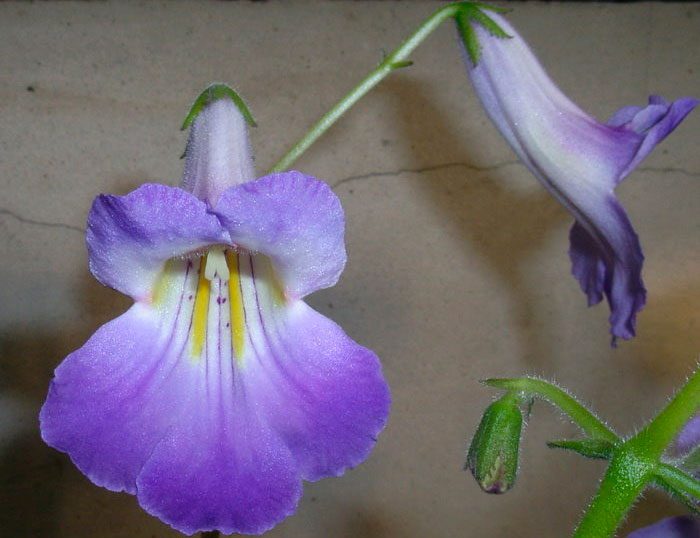

Atsuko - rounded satin leaves with a serrated edge, painted in emerald color. They are perfectly symmetrical and create an exemplary leaf rosette. They also have very showy, large lilac-blue bell-shaped flowers. Their neck is painted white, and yellowish stripes are located on the surface.


"Aiko" - velvet leaf plates have an elongated oval shape, and they make up a very compact rosette. Long peduncles bear flowers of a deep yellow color with a peach tint, while there are reddish specks at the neck.
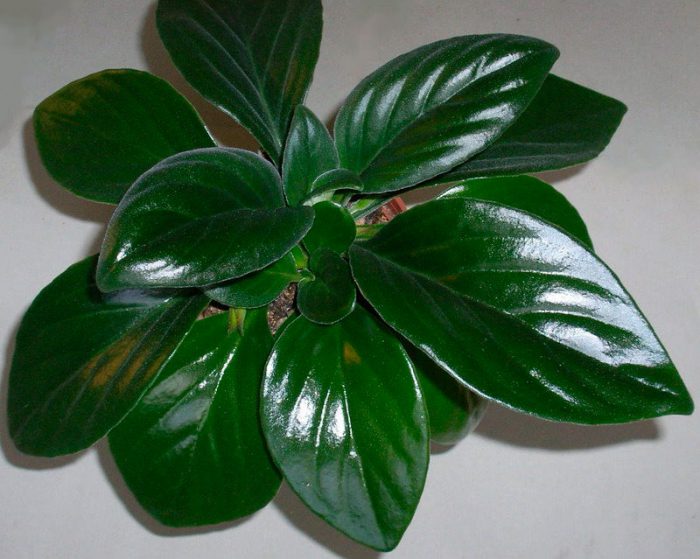

"Junko" - similar to the previous variety. It has a more compact size, and its leaf plates are somewhat wider.


Kazu - the velvet leaves of such a compact plant have a lanceolate shape. It has rather large flowers with a lavender color and a prominent lower lip.
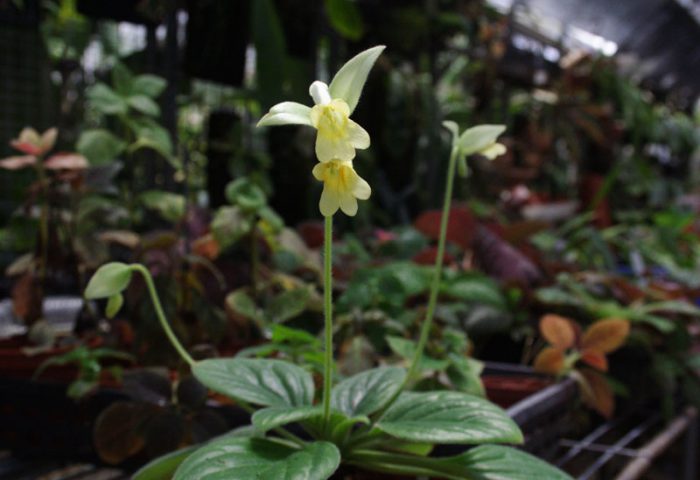

Kitaguni - flowers are painted in yellowish-cream color. Medium-sized leaf plates have a silvery-green color.
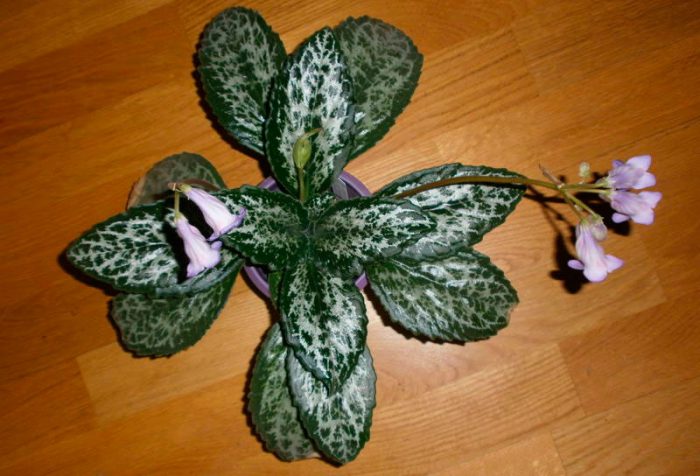

Hisako - such a spectacular plant has variegated foliage. Large wide teeth are located along the edge of the leaf plates, and there are silvery veins on their surface. The flowers are lavender colored and have a lemon neck.
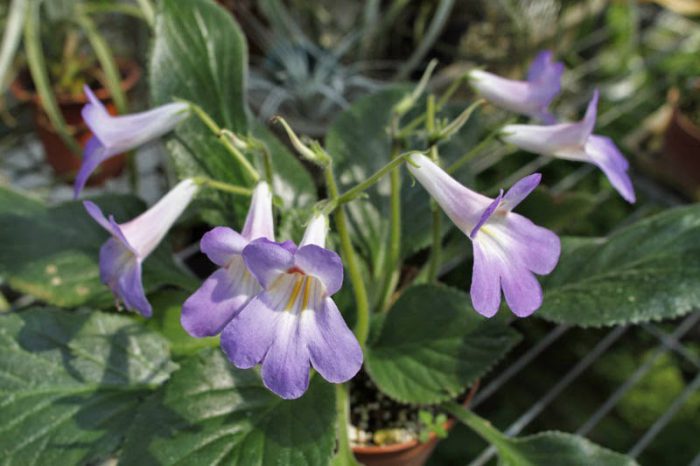

Mineko - oval-shaped leaves have an almost smooth surface and rich color. Bell-shaped flowers have a rich lilac color and a white neck, the petals are rather large and elongated. On the surface of the flower are scattered yellowish-orange specks and stripes.


"Vertigo" (Vertigo) - this unusual variety has deep blue flowers and a whitish neck. Variegated leaf plates have a serrated edge, and in the center there is a diverging herringbone of veins, painted in light green color.
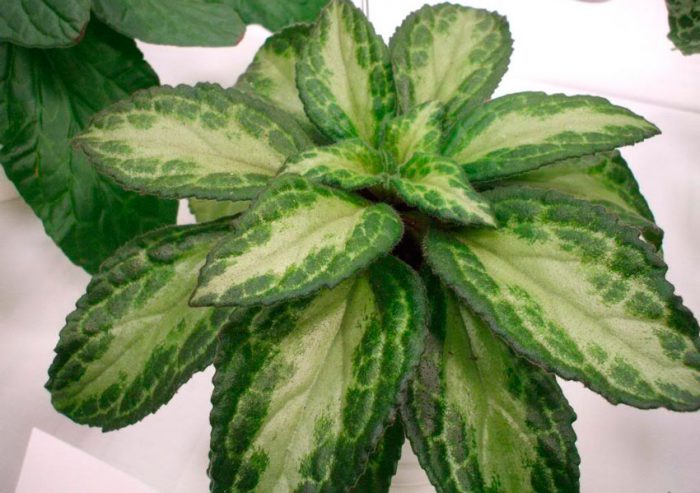

Destiny - this variety has variegated foliage. Wide leaf plates have a lanceolate-oval shape and a serrated edge. On the surface in the central part there are stripes of a silver color. There is also a spectacular pattern in a light color shade, as well as an unusual almost black border. On the surface there is still a pubescence of a burgundy color, but it can only be seen up close.


"Sweet Dreams" - large shiny leaves are olive-colored. Flowers of a light color shade pale-milky.


"Betty" - shiny leaf plates have a dark border and a prominent vein running in the center. A thin silvery pattern is located on the entire surface. The flowers are light blue.


"Souvenir" - a small plant has narrow oval leaves, in the center is a strip of rich light green-silver color. The flowers are pale lilac.
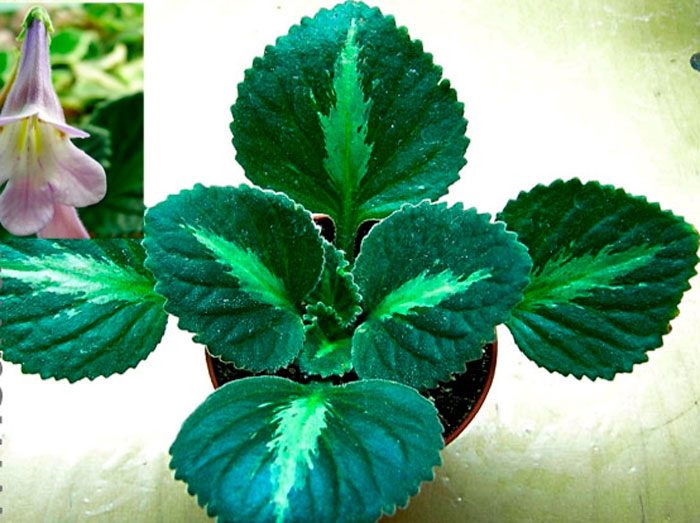

"Marble Leaves" (Marble Leaf) - oval-heart-shaped leaves have a serrated edge, as well as a luminous strip of silver color, passing along the central vein. Lilac-pink flowers have a light yellow neck.


Jade Moon Is a miniature variety. Its small rhombic leaves are part of a perfectly symmetrical rosette. Large flowers are lavender in color. The rosette diameter of an adult specimen does not exceed 15 centimeters.


Moonlight - this variety is considered the most watercolor. On the surface of its oval-elongated leaves, which have a rich color, there is a light marble pattern. Long stalks bear unusual flowers. Along the rim, the rim is painted in a dark purple color, turning into an almost white base. The neck is white, and there are specks of orange color on the surface.
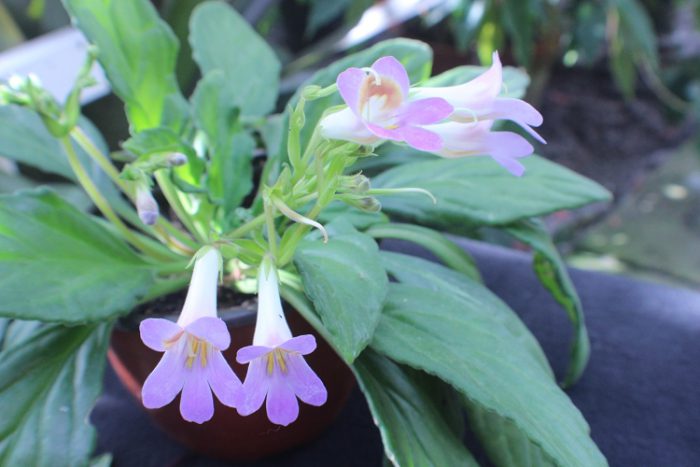

"Piccolo" (Piccolo) - this compact variety is more popular. In the center of its spectacular dark-colored leaf plates, there is a luminous strip of olive-green color. The flowers are lilac in color, and there are orange specks in their light throat.
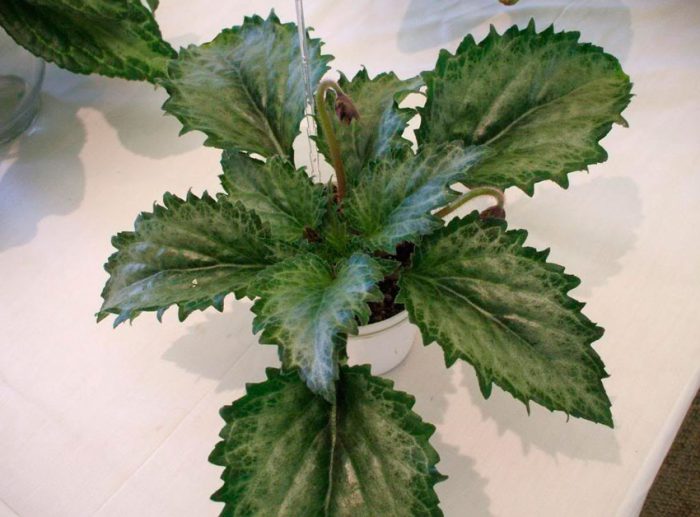

Diane Marie - this compact variety is variegated. Dark emerald oval leaves have large teeth along the edge, and on the surface they have a marbled silvery-whitish pattern. Quite large flowers are painted in lilac color, and on the surface they have stripes of yellow, as well as dark purple.


Huba - rather large ovoid leaf plates have oval edges. They are painted in dark green and decorated with a large network of patterns of a silvery color, while in the central part the pattern is almost invisible, and closer to the sides it becomes brighter.
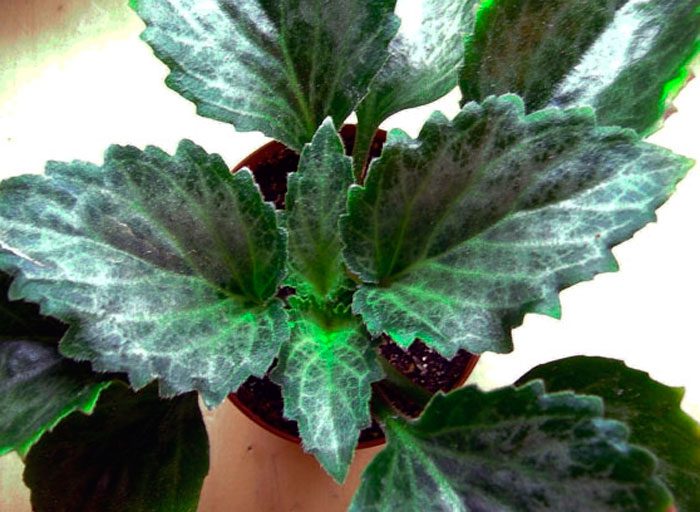

"Lola" (Lola) - diamond-shaped leaves, having a steel shade, are decorated with large teeth along the edge. They are assembled into a socket with perfect symmetry. The bell-shaped flowers are painted in a dark lilac color, and on their surface there are rich stripes of purple and orange color.


"Nimbus" (Nimbus) - on the surface of the oval leaves of this compact plant, there are strips of pearlescent color. Very cute flowers are outwardly similar to gramophones and are painted lilac-white.


Rachel - this plant is miniature. Small leaves are almost lanceolate, and in the central part there is a white stripe. Lilac flowers are decorated with stripes and an orange or yellow spot.


Patina - leaf plates have a lingual-oval shape. A speck of pearlescent color is clearly visible on their surface, and the effect of a bronze patina is also noticeable (due to the pubescence of the pink color). The lavender flowers have orange stripes on the surface.


Erika - the variety is watercolor. The leaflets are elongated with a wrinkled surface. There is a venous pattern on the light lilac flower petals.
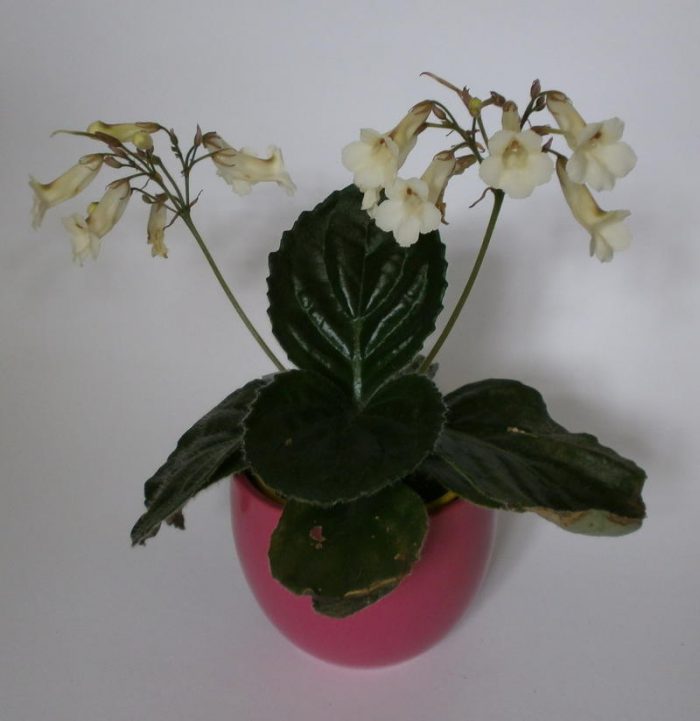

New York - wide saturated color leaf plates are drooping and have streaks of a light color shade. Loose inflorescences consist of flowers of a watercolor pinkish-white color. On the outer surface of the tube there is a hump of crimson color.
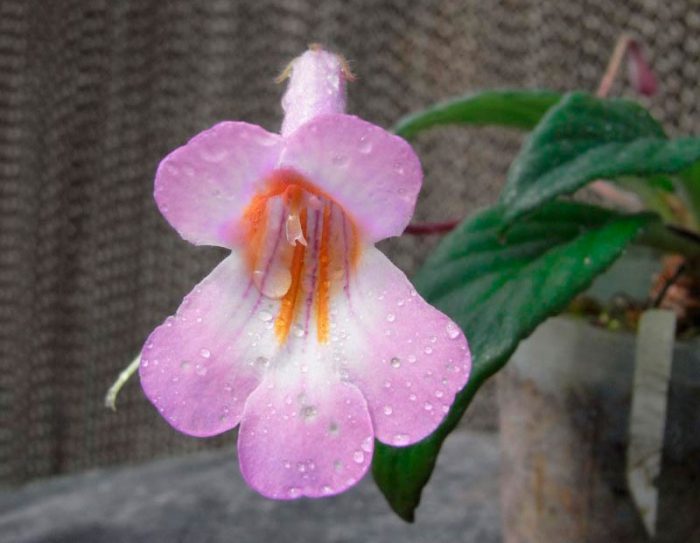

Periwinkle - saturated color, shiny leaves have a pointed shape. The flowers are large enough lavender in color.

